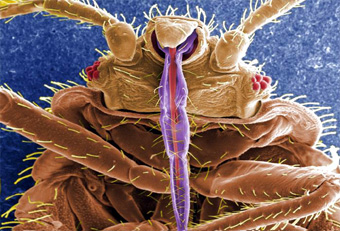
Bedbug, Up Close and Personal
| published October 10, 2015 |
By Thursday Review staff
The horrifying Halloween monster shown in the photo is not a costume for Trick-or-Treat, nor is it a promotional still from a horror movie. This colorful image is a close-up studio portrait of a cimex lectularius, or the common North American bedbug. The image was captured using a scanning-electron micrograph, digitally enhanced to heighten the color. The photo, according to the Centers for Disease Control in Atlanta, helps scientists better understand the “ultrastructural morphology” of the bedbug’s underside and face.
The sharp, syringe-like structure in lavender and red is the piercing tool used by the bedbug to extract blood and fluids from its target victim. As the name would indicate, bedbugs are most commonly found in highly sheltered areas (such as mattresses and box springs) where they can easily reach their victims. Bedbugs produce a distinctive odor, the result of secretion glands located near the insect’s mouthparts. A substantial infestation of bedbugs can cause a generalized odor in a bedroom, or in the infested room of a motel or hotel.
Their bites are generally harmless, and can be most easily treated with topical antiseptic creams and lotions. Some people may be more allergic to their bite than others. Bedbugs, according to the CDC, “are not effective vectors of disease,” though they have been found to internalize some forms of blood-borne pathogens. Items or rooms infected can be best treated with professional forms of insecticide, but because many pesticides—in large quantities—can produce toxic conditions for humans and pets, a badly infected mattress or bed may require being disposed of completely.
The CDC recommends that owners of motels, hotels and businesses contact local health departments for specific advice for eradicating these pests. Home owners should contact a reputable pest control company, as most over-the-counter treatments are limited in their effectiveness.
Related Thursday Review articles:
Ragweed Allergies Year Round?; Thursday Review staff; Thursday Review; March 23, 2015.
Ebola, Magnified X25K; Thursday Review staff; Thursday Review; September 5, 2014.
